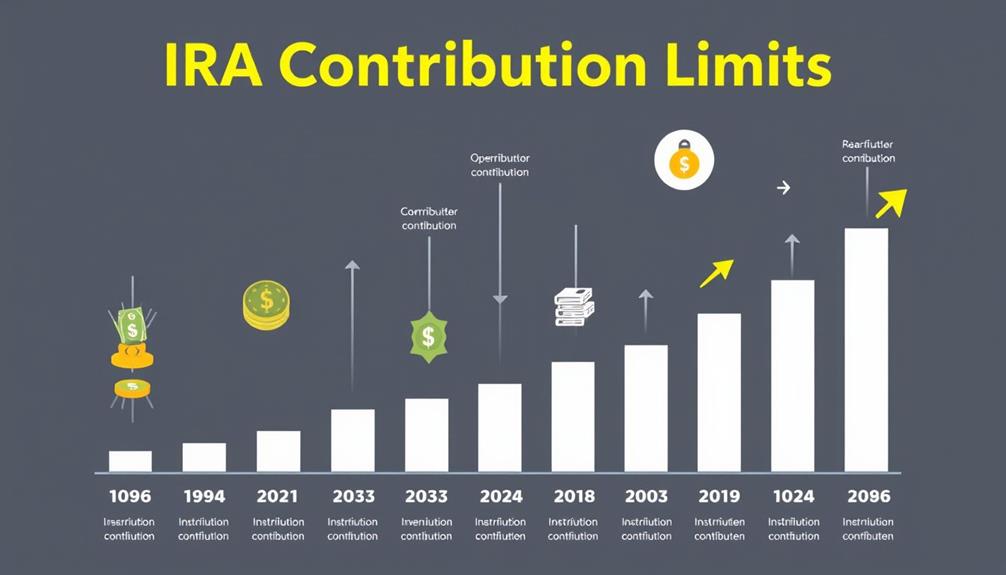Sure enough, the **Individual Retirement Accounts (IRAs)** have come a long way since their inception in 1974. Originally focused on **tax-deferred savings**, IRAs have witnessed a rise in **contribution limits** over the years, soaring from $1,500 to $6,500 in 2023. The advent of the **Roth IRA** in 1997 introduced after-tax contributions and tax-free withdrawals, adding a fresh dimension. It’s worth noting that approximately 42.2% of U.S. households now hold IRAs, reflecting their increasing popularity. Recent legislative adjustments like the **SECURE Acts** are continually shaping retirement planning. There’s a lot more to discover, including the influence of 401(k) plans and future trends in retirement accounts. Dive in to unravel the intriguing world of IRAs and retirement planning!
Key Takeaways
- IRAs were created in 1974 under ERISA, initially allowing tax-deferred contributions to enhance retirement savings.
- The introduction of the Roth IRA in 1997 allowed for after-tax contributions and tax-free withdrawals, diversifying retirement savings options.
- Contribution limits for traditional IRAs have significantly increased, from $1,500 in 1974 to $6,500 in 2023, reflecting inflation and changing financial needs.
- Required Minimum Distributions (RMDs) were introduced, mandating withdrawals starting at age 73 for traditional IRAs, while Roth IRAs remain exempt from RMDs.
- Recent legislation, like the SECURE and SECURE 2.0 Acts, improved access to retirement plans and introduced automatic enrollment features, boosting savings efforts.
Historical Development of IRAs

The historical development of Individual Retirement Accounts (IRAs) began in 1974 when they were created under the Employee Retirement Income Security Act (ERISA). These accounts provided you with a tax-deferred option for retirement savings, particularly for those without employer-sponsored pensions.
Initially, the contribution limit was set at $1,500, allowing you to start building your nest egg. Over the years, this limit has increased, reaching $6,500 in 2023 and $7,000 for individuals under 50 in 2024. Understanding common financial terms related to IRAs can further enhance your retirement planning.
However, changes came with the Tax Reform Act of 1986, which phased out deductibility for higher-income earners. This shift impacted IRA participation for affluent individuals, making it a bit more challenging for them to benefit from these retirement accounts.
In 1997, the introduction of the Roth IRA transformed the landscape further, allowing for after-tax contributions and enabling tax-free withdrawals in retirement.
Today, IRAs play a substantial role in your retirement planning, with about 42.2% of U.S. households owning one, and total assets in IRAs reaching $13.0 trillion. This evolution underscores the importance of IRAs in helping you secure your financial future.
Impact of Social Security

When the Social Security Act was established in 1935, it aimed to provide financial security for retirees who otherwise had little support.
However, as you might know, Social Security benefits often fall short, making it essential to explore other retirement savings options like IRAs.
One option worth considering is a Gold IRA, which offers unique benefits such as potential for long-term capital appreciation and serves as a hedge against inflation.
Understanding the limitations of Social Security can help you better plan for a stable financial future.
Social Security Origins
Historically, Social Security has played an essential role in shaping retirement planning for millions of Americans. Established by the Social Security Act of 1935, this national retirement program aimed to provide a reliable source of retirement income, especially during the difficult times of the Great Depression. At that time, only 15% of the workforce had formal retirement plans, highlighting the urgent need for a government-backed safety net for seniors.
As individuals seek to enhance their retirement security, many are looking into options like rolling over their 401k into a Gold IRA, which can offer tax advantages and long-term protection against market volatility.
Funded by worker contributions through payroll taxes, Social Security laid the groundwork for a social insurance model that has supported countless individuals since its inception. While it remains a vital source of income for retirees, many find that it often falls short of covering all living expenses. This gap emphasizes the importance of additional retirement savings, leading many to explore individual retirement accounts (IRAs).
Over the decades, Social Security has adapted to demographic changes, such as increasing life expectancies, raising concerns about its long-term sustainability.
As you plan for your future, understanding the origins and evolution of Social Security can help you make informed decisions about your retirement strategy, ensuring you're prepared for what lies ahead.
Financial Security for Retirees
Many retirees rely heavily on Social Security to maintain their financial security in later years. Established by the Social Security Act of 1935, this program has evolved to provide essential support for a significant portion of the elderly population. By 2023, Social Security made up about 30% of the income for retirees, underscoring its significance in ensuring a stable retirement.
However, it's important to acknowledge that the average monthly benefit of around $1,800 often falls short of covering all living expenses, leaving many seniors in a precarious financial situation. This reliance on Social Security highlights the challenges faced by retirees, especially those who lack additional sources of income or savings.
Furthermore, with projections indicating that the trust fund reserves may be depleted by 2034, concerns about future benefits grow. You might find it increasingly important to evaluate other retirement savings options, like IRAs, to supplement your Social Security income.
As you plan for your retirement, understanding the role of Social Security in your overall financial strategy is crucial for securing the financial support you'll need in your later years.
Challenges and Limitations
Social Security, while an essential safety net, has significant challenges that can impact retirees' financial well-being. Originally designed to support those without retirement plans, it now struggles to provide enough income for many seniors. With benefits often falling short of basic living expenses, relying solely on Social Security can lead to financial hardship. This is especially true as life expectancy increases, leaving many retirees at risk of outliving their benefits.
You might find that your retirement savings are important to fill the gaps left by Social Security. The introduction of IRAs in 1974 addressed this issue, allowing individuals to save independently. However, the IRA contribution limit can restrict how much you can set aside for the future.
Additionally, taxes on withdrawals can further complicate your financial strategy. As you plan for retirement, it's critical to reflect on how Social Security interacts with your overall savings strategy.
Balancing Social Security benefits with robust retirement savings through IRAs and other accounts can help guarantee you're financially secure in your golden years. Don't underestimate the importance of diversifying your income sources to achieve lasting stability.
The Rise of 401(k) Plans

The emergence of 401(k) plans in the late 1970s revolutionized how Americans save for retirement. Introduced in 1978, the 401(k) allowed employees to make pre-tax contributions and deferrals, transforming retirement plans into a defined contribution model. This shift meant that you, as an employee, now had greater control over your savings.
Ted Benna implemented the first 401(k) savings plan in 1980 and advocated for auto-enrollment, which has greatly increased participation rates. By 2021, around 68% of private sector workers had access to retirement plans, with 401(k)s being a dominant option.
The 1981 IRS clarification on payroll deferrals further solidified the popularity of these plans, leading to nearly half of major employers offering them by the end of 1982. As 401(k) plans gained traction, they shifted the responsibility of saving for retirement from employers to employees, contributing to a decline in traditional pension plans.
This evolution underscores the importance of being proactive about your retirement savings. With a 401(k), you're empowered to build your future, making informed choices about your financial security.
Evolution of Roth IRAs

Roth IRAs have transformed the landscape of retirement savings since their introduction in 1998. Formalized by the Taxpayer Relief Act of 1997, these accounts allow you to make after-tax contributions, enabling you to enjoy tax-free withdrawals in retirement.
Initially, the contribution limit was set at $2,000 annually, but it's set to rise to $7,000 in 2024 for those under 50, reflecting the growing significance of these accounts in your retirement planning.
As of 2023, about 31.9 million households, or 24.3% of the U.S. population, own a Roth IRA, highlighting its widespread appeal.
One of the most attractive features of Roth IRAs is that they don't impose Required Minimum Distributions (RMDs) at age 73, allowing you to keep your savings intact for a longer period. This flexibility can be essential in managing your retirement funds and maximizing your financial security.
Required Minimum Distributions Explained

Understanding Required Minimum Distributions (RMDs) is essential for managing your retirement accounts effectively. If you have traditional IRAs or 401(k)s, you'll need to start taking RMDs at age 73. Failing to withdraw the required amount can lead to a hefty penalty of 50% on the amount you should've taken out.
Here's a quick overview of RMDs:
| Aspect | Details |
|---|---|
| Starting Age | Begin at age 73 |
| Penalty | 50% tax on the amount not withdrawn |
| Roth IRAs | Exempt from RMDs during your lifetime |
RMD amounts are calculated using your account balance from the previous year and IRS life expectancy tables. It's worth noting that the SECURE Act recently changed the starting age for RMDs from 70½ to 73, reflecting the longer life expectancy of retirees today. Understanding these rules can help you avoid penalties and make informed decisions about your retirement savings.
Recent Legislative Changes

Recent legislative changes have considerably impacted your retirement planning options.
With the SECURE 2.0 Act, you're seeing new features like mandatory employee enrollment and enhancements to Roth IRAs that make saving easier and more beneficial.
These updates not only broaden access but also help you maximize your retirement savings potential.
SECURE 2.0 Overview
The SECURE 2.0 Act represents a significant step forward in enhancing retirement savings for American workers. This legislation builds on the original SECURE Act of 2019, making it easier for you to save for your future.
With mandatory employee enrollment in retirement plans, you'll find it simpler than ever to start saving. Plus, the increased contribution limits for older workers mean you can maximize your retirement savings as you approach retirement age.
Here are some key features of the SECURE 2.0 Act that you should know:
- Expanded access for part-time workers, ensuring everyone can participate
- New rules allowing catch-up contributions for those over 50
- Enhanced savings potential with higher contribution limits
- Mandatory automatic enrollment to boost participation rates
- Increased focus on long-term retirement strategies for an aging population
These changes reflect a growing recognition of the need for robust retirement savings strategies.
Roth IRA Enhancements
With the SECURE 2.0 Act paving the way for enhanced retirement savings options, significant improvements to Roth IRAs have emerged. One of the standout features is the ability for employers to make matching contributions to Roth accounts, effectively boosting your retirement savings potential.
As of 2023, the contribution limits for Roth IRAs are set at $6,500, with an additional catch-up contribution of $1,000 for those aged 50 and older.
Another key change is the elimination of the income cap for Roth conversions. This means that even high-income earners can now convert their traditional IRAs to Roth IRAs without facing limitations. This flexibility allows for better tax planning and wealth management strategies.
Moreover, Roth IRAs continue to offer tax-free withdrawals after age 59½, which is a huge advantage for your retirement. Plus, there's no requirement for minimum distributions (RMDs), giving you more control over your funds.
The ongoing increase in contribution limits, indexed to inflation, signals a commitment to improving retirement savings accessibility through Roth IRAs. These enhancements make Roth IRAs an increasingly attractive option for your financial future.
Comparing Retirement Savings Options

When you're planning for retirement, choosing the right savings option can make a notable difference in your financial future. You've got several choices, each with its own benefits.
For example, 401(k) plans allow higher contribution limits at $23,000 compared to the $7,000 limit for IRAs. This can enhance your savings quickly, especially if your employer offers matching contributions.
On the flip side, IRAs provide more flexible investment options, letting you invest in a wider range of assets like stocks, bonds, and mutual funds.
Consider these emotional aspects when weighing your options:
- The thrill of watching your savings grow.
- The peace of mind knowing your future is secure.
- The satisfaction of making informed financial choices.
- The joy of retiring on your own terms.
- The freedom to enjoy life without financial stress.
Moreover, the tax treatment varies notably. Traditional IRAs allow for pre-tax contributions, while Roth IRAs offer tax-free withdrawals.
Deciding between these accounts requires careful consideration of your retirement goals and financial situation. Make sure you choose wisely!
The Role of Financial Advisors

Steering through retirement savings options can be overwhelming, especially with the various accounts available. Financial advisors play a vital role in helping you navigate these complexities, particularly when it comes to IRAs. With around 42.2% of U.S. households owning an IRA in 2023, these professionals educate clients on the benefits of tax-deferred growth and tax-free withdrawals.
Here's how financial advisors support IRA owners:
| Service | Benefits | Target Group |
|---|---|---|
| Personalized Strategies | Tailored plans for your financial goals | All IRA owners |
| Maximizing Contributions | Guidance on catch-up contributions for those 50+ | Older IRA owners |
| Roth IRA Guidance | Insight into tax implications and post-tax benefits | Current and potential Roth owners |
| Regulatory Updates | Information on SECURE Act changes and new strategies | All retirement savers |
Trends in Retirement Planning

As you plan for retirement, you're likely noticing a shift in who's responsible for savings—it's increasingly on your shoulders.
Financial education has never been more essential, helping you navigate the complexities of different retirement accounts and strategies.
Understanding these trends can empower you to make informed decisions for your future.
Shifts in Savings Responsibility
The landscape of retirement planning has dramatically shifted over the past few decades, placing greater responsibility for savings directly in your hands. The introduction of Individual Retirement Accounts (IRAs) in 1981 marked a pivotal change, empowering you to take control of your retirement funds. Gone are the days of relying solely on employer-sponsored pension plans.
With Roth IRAs introduced in 1997, you gained the option to make after-tax contributions, allowing for tax-free withdrawals later. This flexibility has appealed to many, highlighting the importance of self-funded retirement.
As of 2023, around 42.2% of U.S. households own an IRA, a massive leap from just 15% in 1935. This shows how much you and others value taking charge of your retirement savings.
The SECURE Act and its successor, SECURE 2.0, continue to promote individual engagement in retirement planning by making saving more accessible.
- You're responsible for your future.
- Your choices can secure your dreams.
- Every dollar saved makes a difference.
- It's never too late to start.
- Planning now can ease future worries.
Embrace this responsibility and invest wisely!
Importance of Financial Education
Financial education is increasingly vital in today's retirement landscape, where you bear more responsibility for your savings than ever before. The shift from defined benefit pension plans to defined contribution plans, like 401(k)s and IRAs, places greater emphasis on your understanding of how these retirement accounts work. As of 2023, about 42.2% of U.S. households own an IRA, underscoring the need for you to grasp the various types of retirement accounts and their benefits.
With the SECURE Act of 2019 expanding access to retirement plans for part-time workers, staying informed about new savings opportunities is essential. Additionally, as life expectancy increases—averaging ten years longer since 1978—your retirement planning has to guarantee that your savings last throughout this extended period.
Moreover, the rise of automatic enrollment and the popularity of target-date funds highlight a trend toward simplifying investment choices. However, understanding these tools and their implications for your retirement savings still requires solid financial education.
Future of Retirement Accounts

Retirement accounts are on the brink of significant transformation, driven by evolving regulations and changing investor preferences. The SECURE 2.0 Act has introduced permanent changes aimed at making retirement savings more accessible and encouraging greater employee participation.
You'll likely see an increase in target-date funds, simplifying investing by automatically adjusting asset allocation as you approach retirement.
Here's what to expect in the future of retirement accounts:
- Enhanced accessibility through technology, like robo-advisors
- A shift towards ESG investments that reflect your values
- More diversified savings strategies for future generations
- Increased participation rates among employees due to new regulations
- Simplified investment options tailored to your lifestyle
These changes not only make it easier for you to manage your savings but also align your investments with your personal beliefs and goals.
As demographics shift, the demand for flexible, diverse retirement savings will reshape retirement accounts, ensuring they meet the needs of a new generation.
Embrace these transformations; your future self will thank you for being proactive in your retirement planning.
Frequently Asked Questions
How Does an IRA Grow Over Time?
An IRA grows over time through tax-deferred investment returns. Your contributions earn interest, and those earnings compound without immediate taxes. With consistent contributions and smart investments, you can greatly boost your retirement savings.
What Is the History of Iras?
You might think IRAs are complicated, but they've evolved considerably since 1974. Initially offering tax-deferred options, they now include Roth accounts and higher contribution limits, making retirement savings more accessible and beneficial for everyone.
What Changes Are Coming to IRA Accounts?
Starting in 2024, you'll see increased contribution limits for IRAs. If you're over 50, you can contribute an extra $8,000. Plus, flexibility in late contributions will help you maximize your retirement savings.
What Happens to Old IRA Accounts?
Old IRA accounts can continue growing tax-deferred until you reach age 73, when RMDs start. If forgotten, funds might go unclaimed. You can also roll them over for tax benefits and investment growth.
Conclusion
As you navigate your retirement planning, remember how far IRAs have come and the options available to you. Consider Sarah, a hardworking nurse, who opened a Roth IRA and watched her savings grow tax-free. Now, she's closer to her dream of traveling the world in retirement. Embrace the evolution of retirement accounts, and take charge of your financial future. With the right strategy, you can secure the life you've always envisioned.









